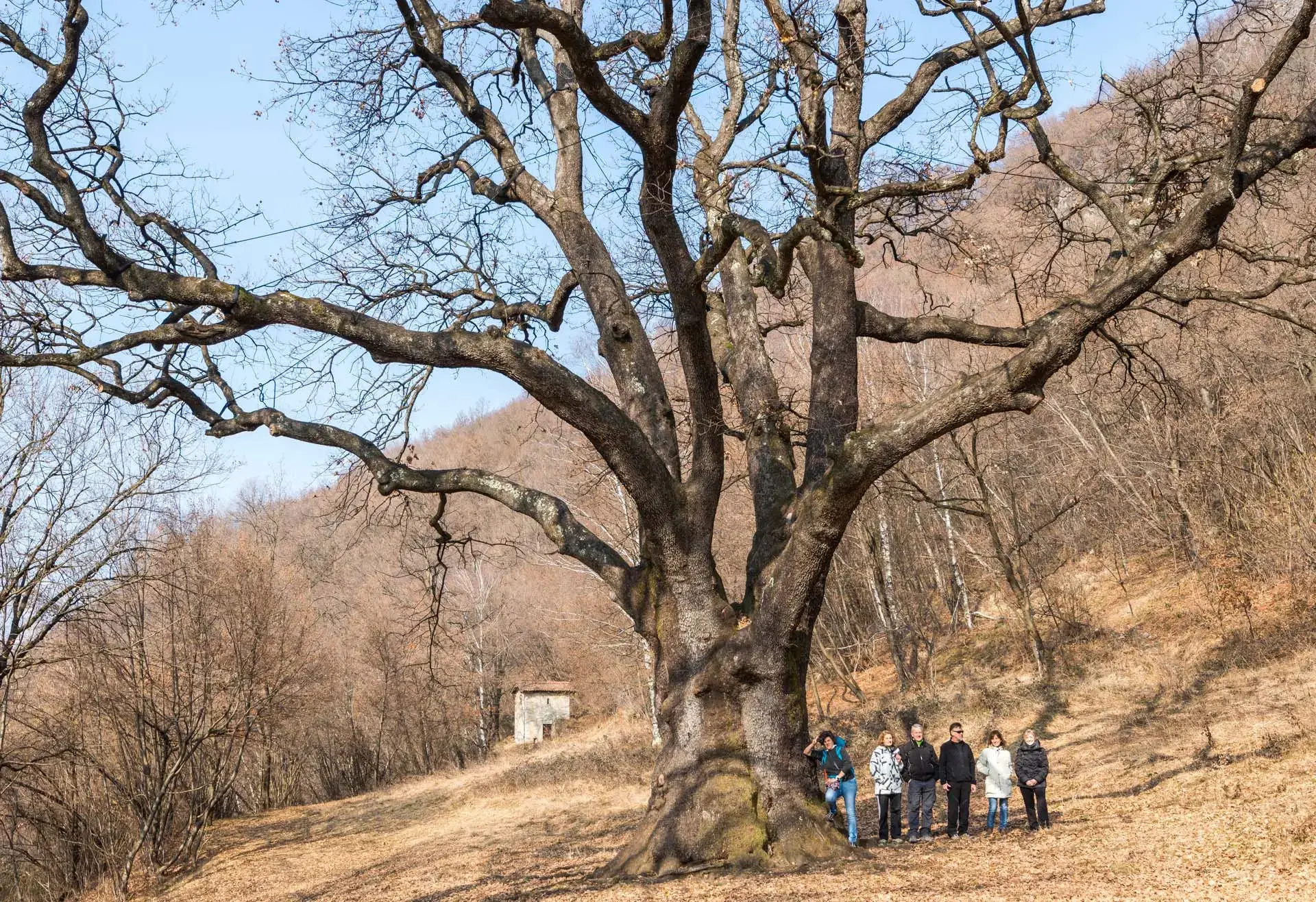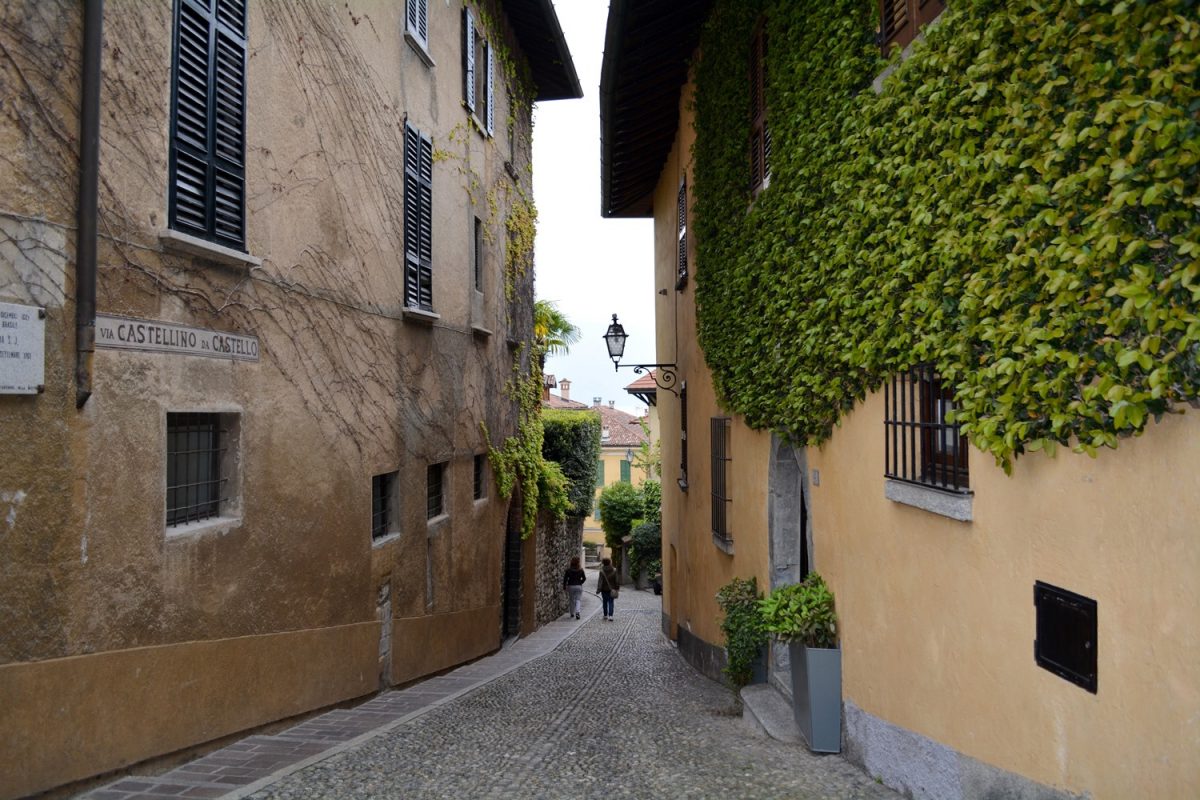
Walk to Rogolone from Menaggio

On a plateau in the municipality of Grandola and Uniti at at an altitude of 479 m there is "Il Rogolone" a large oak tree 25 meters high and 8 meters wide, the largest oak in northern Italy and one of the most majestic in Europe.
- Starting point: Menaggio;
- Itinerary: Menaggio – Cardano – Gonte – Rogolone – Velzo – Codogna – Mulino Vecchia Chioderia – Piamuro – Menaggio;
- Duration: 4.30 hours;
- Signposting: some signs;
- Total climb: 390 m;
- Length: 11.5 km
- Difficulty: quite easy
Itinerary

Starting point Piazza Garibaldi, Menaggio. Take Via Calvi; cross the Statale road and take Via Caronti on the left side of the church of S.Stefano, at the end turn right and after about 30 m. turn left into Via C. da Castello. The remains of the Castle let you imagine what its structure must have been in medieval times. It was in fact destroyed by the Lords of the Grey Leagues in 1523 and completely dismantled.

At the crossroads with Via Strecioum take the long staircase (Via Rezia) on the left which ends in a subway. After the subway, take Via Monte Grappa, which after 300 m comes out on the state road 340, and cross it.
After going up the short flight of steps, turn right onto the cycle/pedestrian path that follows the tracks of the former railway line Menaggio – Porlezza.
You enter a valley and cross a 90 m long tunnel to reach the Municipality of Grandola and Uniti. Further on, the track stops on the Provincial Road of Grandola. Turn right to reach the beautiful historic centre of Cardano, which groups around Villa Bagatti Valsecchi.

The origins of Bagatti Valsecchi date back to the 17th century, although between the 18th and 20th century the building was enlarged and raised.
Beyond the church dedicated to S. Caterina you reach again the Provincial Road of Grandola. Cross it and take Via Gonte which leads to the historical centre of Gonte. From the square, where the church of S. Giovanni Battista is located, take Via alle Vigne on the right side of the church.
The cart track runs along the Menaggio Valley flanked on the left by Monte Crocione (1640 m) and Monte Galbiga (1698 m) and on the right by Monte Grona (1736 m). After about 1 km, at the junction at the height of a house, keep right.
After a short stretch in the woods you pass in front of a small votive chapel and after approx. 500 m you reach a junction where you turn right. Continue slightly uphill through meadows and woods and, after two small fords, you reach a fork where you turn left (sign Rogolone).
The route continues through the woods to arrive, after a last steep climb, at the clearing where you will find the Rogolone, the big oak tree and the Rogolino.

After admiring the oak tree, take the path that leaves the clearing at the top right in the direction of Velzo (sign). After a stretch in the forest you will reach the rural village of Velzo in about 40 minutes.
Cross the carriage road that goes up to Naggio and follow Via Cima that leads to the centre of Velzo. At the house where the road divides, keep to the right (Via Gottro) and, still keeping to the right, you come out onto a small square with a little chapel where you take Via Leopardi on the left, reaching a washhouse. Cross the carriage road again and take the mule track that goes down to Codogna along the beautiful parish church of S. Siro.
You reach Villa Camozzi, seat of the Town Hall and the Ethnographic and Naturalistic Museum of Val Sanagra.
The villa was built in the eighteenth century and looks like a classic residence of that period.

Cross the carriage road near the sports centre and go down Via Mulino to the Sanagra river, following the signs for the Agriturismo La Vecchia Chioderia, an ancient nail and lock factory, built on the ruins of a previous mill. Now it has become a trout farm, as well as an agritourism, an excellent place to taste local specialities. Cross the bridge and take the dirt road (on the right) along the river to reach the Fornace Galli, an ancient brick factory.

Continue on route 4 to reach the locality Mulino della Valle where you take the left towards Piamuro. After passing the Artus Chapel, you will reach Piamuro, a vast pastureland. From here you descend along the carriage road towards the locality Loveno to reach the church of San Lorenzo with its baroque façade.

Loveno was historically a destination for patrician families who built important residences there. This is the case of Villa Garovaglio, and Villa Mylius Vigoni owned by the Federal Republic of Germany and home to the Italian-German cultural centre Villa Vigoni, which organises high-level conferences. The villa and its park can be visited upon reservation tel. 0344 361232.


Go down along Via Garovaglio and then take Via XXIV Maggio on the right which, passing through Villa Belfaggio, comes out in Via Sauro. Follow the signs and take the various shortcuts to get back to Menaggio.
Shortest way to reach Rogolone
From Como you follow the SS340. After entering the Menaggio tunnel, take the Porlezza direction. At Grandola and Uniti divert towards Cardano-Codogna.
Going straight on, you reach, in Codogna, the Town Hall of Grandola ed Uniti (with parking), located in the eighteenth-century Villa Camozzi.
On the fence of the villa, in the lower part, a sign indicates the small flat road that leads to Rogolone. It can be reached in about half an hour and the same is necessary for the return journey. The frequent indications do not allow you to make a wrong way.
More information
Former Menaggio – Porlezza railway line
The railway line from Menaggio to Porlezza, inaugurated in 1884, was created with the aim of increasing tourism in northern Europe to the lake region. Once arrived by train in Lugano, passengers continued by steamship to Porlezza and from there by train to Menaggio. Between the two World Wars, until 1939, the railway line was used as a local transport system and then fell into disuse at the end of the Second World War.
Villa Bagatti Valsecchi
The villa stands on the highest part of Cardano, and is a natural balcony over the unique and suggestive landscape of Val Sanagra. It was built in the year 1700 by Giovanni Battista Guaita, a member of an illustrious local family of high social standing, reached in the previous decades following his emigration to Germany.
The Guaita family also owned a large part of the surrounding valley. Over time the various inhabitants of the house decided to modify the exterior appearance of the building, adapting it to the medieval style of the village of Cardano.
In the nineteenth century the property first passed to the Galbiati barons then, in 1896, the house was inherited by the Bagatti – Valsecchi di Belvignate, the current owners.
The entrance is situated on a small square in the town, surrounded by old stone houses embellished with “graffito” decorations typical of the alpine valleys in the area. The bodies are arranged in a “U” shape, anticipated by a beautiful wrought iron gate overlooking the square. The height of the house varies: from the three floors of the part towards the village to the two of the inner part. The Galbiati barons also added a loggia – tower on the roof.
Rogolone and Rogolino
Rogolone and Rogolino are two monumental examples of oak, and are also known by the dialect names “Rugulon” and “Rugulin”. Located in the municipality of Grandola and Uniti, at an altitude of 450 m, they grow in a clearing belonging to the hamlet of Velzo, near the “Bosco Impero”. The Rogolone, in particular, is a centuries-old oak of exceptional dimensions: 8 m in circumference and 25 m in height, making it the largest oak in northern Italy and one of the most majestic in Europe.
The tree, owned by the association Italia Nostra, has been protected as a National Monument since 18th December 1928 and, since 2001, is also the symbol of the Val Sanagra Museum. The large dimensions of the two trees have in the past inspired legends and beliefs about their age: up to a few years ago it was thought that the Rogolone should be hundreds or even thousands of years old. Tradition linked the big oak tree to the place where the elders of the neighbouring villages had gathered to mark the borders between the territories, in the year 1530; according to other interpretations the two trees would have been the reference point of a place where, in ancient times, a pagan festival was celebrated in honour of spring accompanied by magic-religious rituals. Even until the ’80s there were beliefs that the plant was about 1500 years old. The disputes were resolved in 1988, when Italia Nostra organised a party at Rogolone entitled
“The Rugulon: the story of a tree”, during which the results of the dating carried out by the Dendrochronological Laboratory of Lausanne were made public: the Rogolone has been growing since 1730 and is therefore about 280 years old, while the Rogolino since 1820 and is 90 years younger.
Villa Camozzi
Villa Camozzi in Grandola d Uniti was built in the eighteenth century and is a classic residence of that period. The villa houses the Naturalistic Ethnographic Museum of Val Sanagra. The museum preserves evidence of the history and popular traditions of the valley. Various naturalistic environments are recreated here, including exhibitions of fossils and mushrooms, dioramas relating to fauna, a documental exhibition of the former Menaggio-Porlezza railway, a room dedicated to music and numerous tools belonging to peasant civilizations. In summer, it is also possible to visit the clay kiln. The furnace is located on the Sanagra river, which can be reached from the hamlet of Codogna.
Fornace Galli
The kiln is an example of industrial archaeology: inside it there is a firing kiln and the necessary equipment for processing the clay using the motive power of water. The building, restored and put into operation, is the seat of the Val Sanagra Park.
Artus Chapel
The chapel is subject to a restoration commissioned by the Alpine Group of Grandola and Uniti, which is currently being completed. Located right on the border between Grandola and Uniti and Menaggio, it flanks the dirt road that from Piamuro leads to the mill of the Valley, the ancient Regina and the village of Codogna.
The name “Artus” has no reference to the protagonist of the legend but derives from Artusio, the historical name of the place where the Chapel was built.
The building is one of the most significant testimonies of the ancient popular religiosity of the territory because of the legend that accompanies it. The original interior, of which a beautiful canvas dedicated to the Holy Mary was remembered, has unfortunately been lost, the current one is the result of restoration work and has a beautiful wooden high relief with a subject inspired by the legend linked to the chapel.